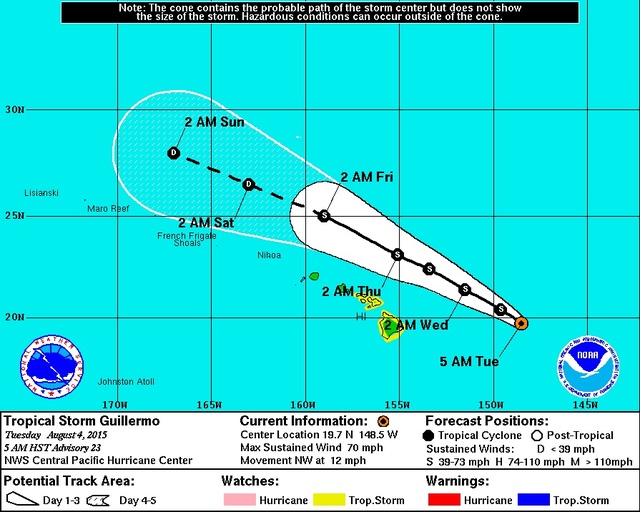The Big Island and Maui are under a tropical storm watch as Tropical Storm Guillermo, formerly a hurricane, makes its way towards Hawaii. ADVERTISING The Big Island and Maui are under a tropical storm watch as Tropical Storm Guillermo, formerly
The Big Island and Maui are under a tropical storm watch as Tropical Storm Guillermo, formerly a hurricane, makes its way towards Hawaii.
Guillermo, as of 5 a.m. Tuesday, was about 430 miles east of Hilo. Maximum sustained winds are about 70 mph, just below hurricane strength. The storm is moving to the northwest at about 12 mph.
Little change in strength is expected today, but slow and steady weakening is forecast starting Wednesday as the storm nears the island; however, it is expected to remain a tropical storm.
The center of Guillermo is forecast to pass about 215 miles northeast of Hilo Wednesday afternoon and about 165 miles north of Maui Wednesday night.
Tropical storm force winds of 39 mph and higher extend about 175 miles from Guillermo’s center.
Forecaster Chris Brenchley said although the storm track shows Guillermo missing the island, there still could be strong surf, gusty winds, heavy rain and thunderstorms.
“Although Tropical Storm Guillermo shows signs of weakening, we strongly encourage residents and visitors to prepare themselves and their families for potential severe weather,” said Doug Mayne, administrator of the Hawaii Emergency Management Agency, in a statement. “There is some uncertainty associated with weather forecasting, so we need to plan for the worst and hope for the best.”
Forecasters said people should monitor the progress of Tropical Storm Guillermo. NOAA said Guillermo already is producing rough surf along east-facing shores of the islands.
National and state organizations were providing advisories, closing areas and otherwise preparing for whatever the storm brings.
HEMA advised people to check with local media to ensure they are up to date. It also warned against driving through fast-moving water, especially if the depth is unclear.
The Coast Guard had several warnings for mariners and the general public, including obeying the instructions of lifeguards.
“Even the best swimmers can fall victim to the strong waves and currents caused by storms,” states a press release.
Boaters also have a special source of information, the Coast Guard wrote.
“Boaters can monitor the progress of the storms on VHF channel 16. Small craft advisories and warnings are also broadcast on VHF channel 16,” the release said.
Those who own boats should secure them and their equipment. Owners of large boats are advised to take the vessels into protected marinas, where they are less likely to be damaged. Smaller boats might need to be pulled from the water and taken to areas not prone to flooding.
The National Park Service will close all backcountry trails in Hawaii Volcanoes National Park at 5 p.m. today. Mauna Loa Road from Kipukapuaulu to the Mauna Loa Lookout, and the Namakanipaio Campgrounds and A-frame cabins, will close at the same time. The visitor centers, restrooms, lava tube, front-country trails, steam vents and other features will remain open.
This won’t be the end of the storm season, NOAA said.
Forecasters called for a busier Central North Pacific hurricane season this year thanks in part to El Niño. Projected climate conditions point to an above-normal hurricane season for the Central North Pacific basin, an area located north of the equator spanning from 140 degrees west longitude to the International Date Line.
At the onset of the season, Central Pacific Hurricane Center officials predicted five to eight tropical cyclones — a category that includes tropical depressions, tropical storms and hurricanes — would pass through the basin this year.
The center also forecast a 70 percent chance of an above-normal season, a 25 percent chance of normal season and a 5 percent chance of a below-normal season.
The Central Pacific hurricane season is June 1 to Nov. 30. The Central Pacific sees an average of four to five tropical cyclones in its waters a year.
Hawaii Tribune-Herald reporter John Burnett contributed to this story.
Email Graham Milldrum at gmilldrum@westhawaiitoday.com.



